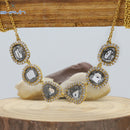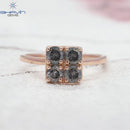Cut
Cut refers not to a diamond's shape (e.g. round, oval, pear, etc.) but to a diamond's proportions, symmetry and polish. The beauty of a diamond depends more on cut than any other factor. Though extremely difficult to analyze and quantify, diamond cut has three primary effects on appearance: brilliance (the brightness created by the combination of all the white light reflections from the surface and the inside of a polished diamond), fire (the dispersion of light into the colors of the visible spectrum, seen as flashes of color), and scintillation (the flashes of light and dark, or sparkle, when a diamond or light source is moved).
When a diamond is fashioned from a rough stone, the cutter must balance optimal cut (and therefore appearance) against maximum yield (cutting the diamond to maintain as much carat weight from the rough stone as possible). Because many customers are willing to pay more for a larger, fair-cut cut diamond than for a slightly smaller, well-cut diamond, there is pressure on the cutter to sacrifice appearance for weight. This is why the Cut grade is so important; it allows the purchaser to identify those stones that were cut Fair to Poor in an effort to gain carat weight.
DIAMOND CUT PROPORTIONS
Diamond proportion refers to the relationship between the size, shape, and angle of each facet of a diamond. A wide range of combinations are possible, ultimately determining the diamond's interaction with light.
When light strikes a diamond, approximately 20% immediately reflects off the surface (as glare). Of the 80% that enters, a portion will escape through the bottom of the diamond (where the observer cannot appreciate it). A well-proportioned diamond will have each facet properly placed and angled so as to maximize the amount of light that reflects back out of the crown (top) of the diamond, to the eye of the observer. This reflected light is perceived as scintillation, fire and brilliance.
In the diagram below, three common light patterns are shown. When light meets any facet of a diamond, it will either reflect (bounce back) or refract (bend while passing through the facet). The angle that the light hits the facet determines whether the majority of light reflects or refracts, which is why cut is so important.
DIAMOND DEPTH %
Depth refers to the distance between the culet and the table when the diamond is viewed from the side. Diamond depth is expressed in millimeters, and is given as the third number under " measurements" for every Lumera Diamond (the first two numbers are length and width).
The depth % of a diamond is calculated by dividing the depth by the width of the diamond. So, if a diamond is 3 mm in depth, and 4.5 mm in width, its depth % is 66.7. The lower the depth %, the larger a diamond of a given carat weight will appear (since most of the diamond's size is in its width vs. in its depth).
DIAMOND TABLE %
The table % of a diamond is calculated by dividing the width of the table facet by the width of the diamond. So, if the table facet is 3 mm wide, and the diamond is 4.5 mm wide, its table % is 66.7.
GRADING DIAMOND CUT

Evaluating the combined effects of facet shapes and angles, girdle width, culet size, polish, and symmetry on the overall appearance of a diamond is a daunting task, even for professional gemologists. Fortunately, all of these factors have already been taken into consideration when calculating the diamond's Cut grade.
Because Cut grade provides a single rating which weighs the combined impact of all of the factors listed above on a diamond's visual performance, it is a simple yet vital tool in evaluating a diamond.
Cut grade should be a primary consideration when evaluating a diamond. Only when comparing two diamonds of the identical Cut grade should the individual components of Cut (such as girdle width, symmetry, polish, depth%, table %, and culet size) be used as further refinements or tiebreakers.
A note of caution:
Unlike the other "Cs" (carat weight, color, and clarity), the various Cut grades in existence today were not originated by GIA, and are not uniformly applied. In fact, GIA has only been assigning cut grades since 2005, and only to round diamonds.
Even though retailers, including Lumera, use common terms to describe Cut (such as Excellent, Very Good, Fair, Poor) the terms are not uniformly defined or applied. In fact, a diamond seller may assign any cut grade they choose, based on any set of factors they wish. One retailer will use terms such as "Signature Ideal", "Ideal", and "Excellent"; while another uses "Ideal" to describe all three, and another uses "Excellent" for all. Be cautious when comparing cut grades from different sources, as they are most likely inconsistent.
To avoid confusion or misrepresentation of any diamond, Lumera uses the same cut grades as employed by GIA, and does not engage in "cut inflation" by creating other grades ("signature", "super ideal", etc.).
Also, be aware of diamond sellers who assign their own cut grades in place of what GIA has already assigned to a particular diamond. Many popular websites and retail stores display their own, more generous Cut rating, in place of the GIA grade.
At Lumera, the GIA cut grade is always shown. For diamonds without a GIA cut grade (because the diamond was certified before GIA began assigning cut grades in 2005, or is a shape that GIA does not currently assign cut grades to), Lumera will apply its own cut grade according to a proprietary formula. Like GIA, the Lumera cut grade is based on a variety of factors and is conservatively applied. In fact, when comparing our cut grade to that assigned by GIA, the Lumera grade is equal to or lower than GIA 90% of the time.




